Venus flytraps do not automatically close during night time. However, they can activate their traps anytime. If a fly or other insect happens to enter their traps during the night-time (or day-time), the Venus flytrap will attempt to capture it.
There are many plants, especially flowers, that close every night (or day). Flowers that close during night time (or day time) exhibit a behavior called nyctinasty. Nyctinasty is a mechanism that causes plant movements as a result of temperature, light, or other environmental changes. Yet, the traps in Venus flytraps do not exhibit nyctinasty.
Now that you learned that Venus flytraps do not automatically close every night. Let’s learn more about the trap mechanisms and why it doesn’t close during the night-time.
Why do Venus flytraps not close at night (automatically)?
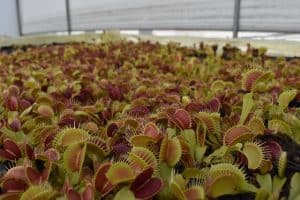 First, Venus flytraps do not exhibit nyctinasty behaviors. Second, the trap mechanisms of Venus flytraps have been perfected over time to conserve energy. Venus flytraps spend significant amounts of energy opening and closing those leaves. Therefore, the plant ensures opening or closing is worth it.
First, Venus flytraps do not exhibit nyctinasty behaviors. Second, the trap mechanisms of Venus flytraps have been perfected over time to conserve energy. Venus flytraps spend significant amounts of energy opening and closing those leaves. Therefore, the plant ensures opening or closing is worth it.
The Trap Mechanism
Why does it need it?
The traps in Venus flytraps are modified leaves. Before looking like the current jaw-like structures we observe today, they were just simple leaves. But, Venus flytraps are native to the wetlands on the east coast of the United States. Their natural habitat characterizes with poor soil (nutrient-free). Because of the lack of nutrients in the ground and the environment, Venus flytraps evolved to be successful predators. Venus flytraps use the nutrients from bugs they catch and consume to supplement their diet and thrive. Here is how Venus flytraps employ their trapping mechanism.
An Energy-Efficient Approach
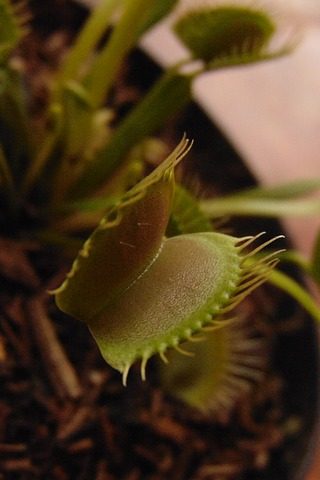 First, Venus flytraps must attract their prey. Venus flytraps produce sweet nectar in their traps to attack potential victims. Once an insect is inside a trap, it might trigger it to close. Each trap is made up of two leaves, and each leaf has three hair cells arranged in a triangular pattern (as seen in the image). The trap only closes when something has touched the hair cells two consecutive times in a short period. The double stimuli mechanism is crucial to avoid closing due to rain, wind, dirt, or any inanimate object touching the trap.
First, Venus flytraps must attract their prey. Venus flytraps produce sweet nectar in their traps to attack potential victims. Once an insect is inside a trap, it might trigger it to close. Each trap is made up of two leaves, and each leaf has three hair cells arranged in a triangular pattern (as seen in the image). The trap only closes when something has touched the hair cells two consecutive times in a short period. The double stimuli mechanism is crucial to avoid closing due to rain, wind, dirt, or any inanimate object touching the trap.
The plant drains significant amounts of energy when it closes its trap. For that reason, Venus flytraps want to be as energy-efficient as possible. If you ever encounter a Venus flytrap, you might be tempted to play with the traps and trigger them. Yet, you should avoid playing with the leaves. The plant won’t die, but it will lose a lot of energy. And they need that energy to live and be ready to catch some real food.
Prey Selection
Once a plant has capture prey, it might release the victim. Why? Well, Venus flytraps are very careful when selecting a meal. For example, when the insect is tiny, it will be able to scape. Venus flytraps have evolved over the years to choose their prey appropriately. We found related information in a Biology paper that studied Venus flytraps from the Journal of Theoretical Biology:
“Among carnivorous plants, the Venus flytrap is of particular interest for the rapid movement of its snap-traps and hypothesized prey selection, where small prey are allowed to escape from the traps (…); the costs and benefits of capturing and digesting its prey; and optimization of trap size and prey selection.” Understanding the Venus flytrap through mathematical modelling
, Sami Lehtinen
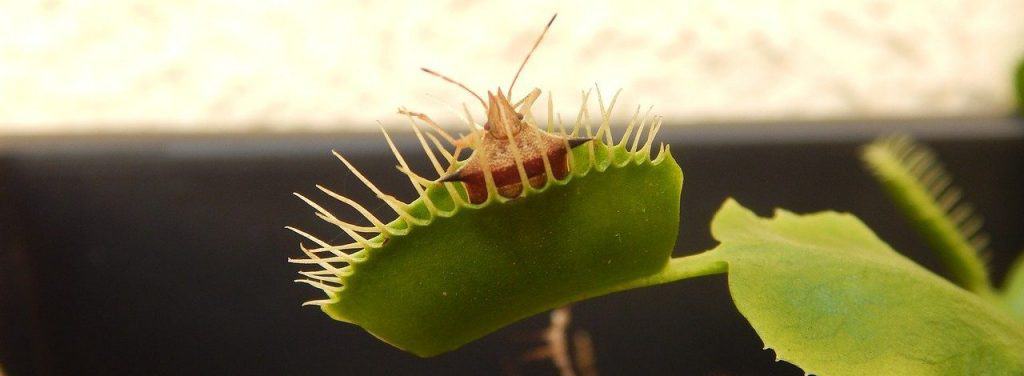
In this study, scientists observed a 76.8% prey release rate for Venus flytraps, which is a significantly high percentage. The findings indicate that these plants are highly selective about prey capture. Venus flytraps select their prey carefully to maximize efficiency. Once the plant has caught prey, it will take a couple of weeks to consume it entirely. Therefore, it must choose carefully.
Related Questions
Why is my Venus flytrap closed right now?
Traps close when they have received the appropriate stimuli. Like we explained previously, Venus flytraps have evolved over the centuries to perfection their response to stimuli. A close trap might be consuming an insect right now! Or it might have attempted to trap a victim. If the prey scaped, then the trap will reopen in a day or two. Once it opens, it will be ready to capture the next victim.
Do Venus flytraps die when they close?
No, Venus flytraps do not die when a trap closes. First, each Venus flytrap has approximately five to ten active leaves (traps) at a time. Each trap is independent and can close when needed. For example, when an insect is crawling inside them.
Even though traps do not die when they close, they can open and close a set number of times before they wither. Once a trap reaches that limit, then it will slowly turn to a black color and die. But do not worry! This process is normal. Generally, a new leaf should grow for every dead one. Start to worry or take action if you notice an increase in black leaves on your Venus flytrap.
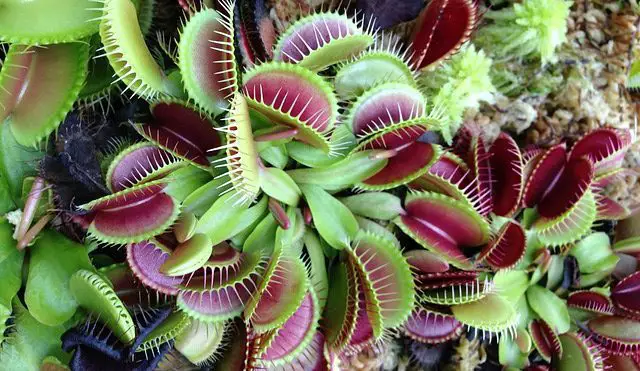
Do Venus flytraps sleep?
Venus flytraps do not sleep, or at least they not like humans. Instead, Venus flytraps undergo a dormancy period. Every year, during late fall or winter (when temperatures drop), Venus flytraps will go dormant.
The plants change dramatically during dormancy. Several leaves wither, and the plant reduces in size. Some first-time growers panic and throw their plants away because they think their plants are dying (or dead). But, in reality, their plants are just experiencing dormancy. The dormancy process is a crucial stage for the plant’s development. For that reason, Venus flytrap should experience dormancy every year (find more information about venus flytrap dormancy in this article) (find more information about venus flytrap dormancy in this article).
In spring, once dormancy is over, Venus flytraps return to their original state and continue to grow and develop. You can learn a lot more about dormancy and the care process in this article: Venus Flytrap Care Instructions
How long do Venus flytraps stay closed?
It depends on why they are close. Generally, there are two scenarios. First, the trap is closed, and it is consuming prey. Second, the trap is closed, but it did not capture anything.
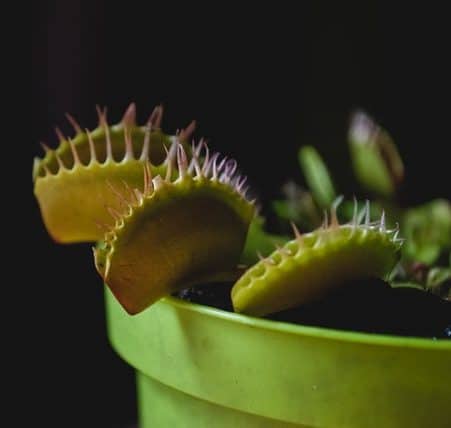 Once a Venus flytrap has caught an insect, it will start the digestion process with enzymes. The Venus flytrap digestion process is unique, but it is not at all fast. It takes one to two weeks to consume an insect. Therefore, in the first scenario, the trap will stay close while it is digesting the prey. The second scenario is much simpler. In that case, the trap will reopen within a day or two.
Once a Venus flytrap has caught an insect, it will start the digestion process with enzymes. The Venus flytrap digestion process is unique, but it is not at all fast. It takes one to two weeks to consume an insect. Therefore, in the first scenario, the trap will stay close while it is digesting the prey. The second scenario is much simpler. In that case, the trap will reopen within a day or two.
There is also an in-between scenario. Sometimes a dead organism or object falls inside a Venus flytrap. The initial motion stimuli can activate a trap. Yet, since the creature inside the trap is dead (or is inanimate), it doesn’t move. The lack of stimuli is a red flag for Venus flytrap. In this scenario, the lack of stimuli might cause the plant to lose interest and reopen without attempting to consume what is inside the trap. This can be a real challenge when trying to feed a Venus flytrap with dead bugs. But do not worry, you can find a way around it in this article :
:
Conclusion
Venus flytraps are fascinating beings. They have not only evolved to be successful predators but also to select their prey in a very meticulous manner. Does it make sense for Venus flytraps to close at night? Absolutely not! Venus flytraps spend large amounts of energy opening and closing those traps. They should only close when a potential victim has been detected inside a leaf.

